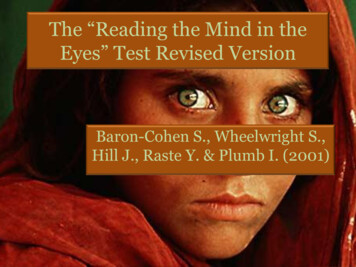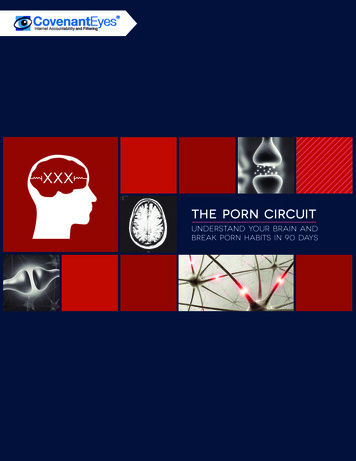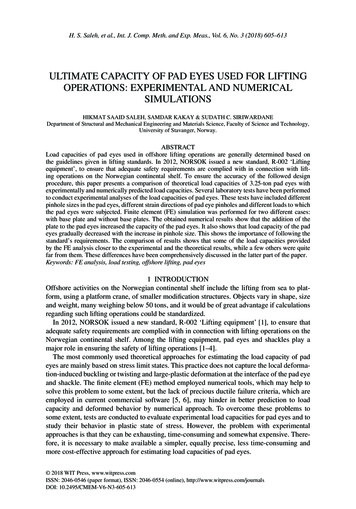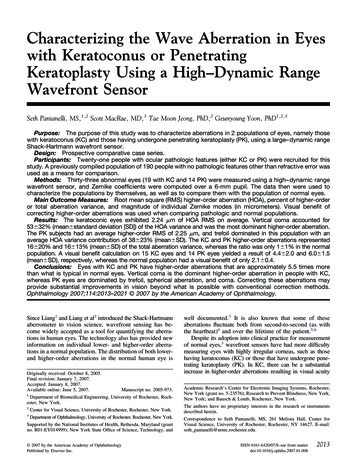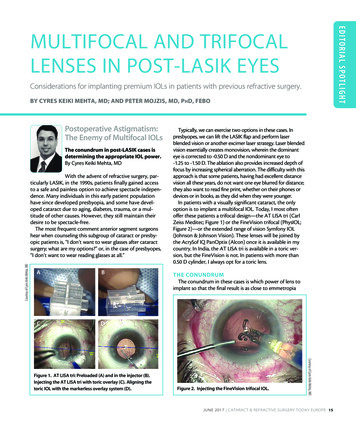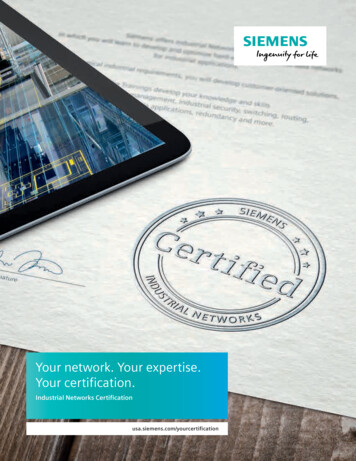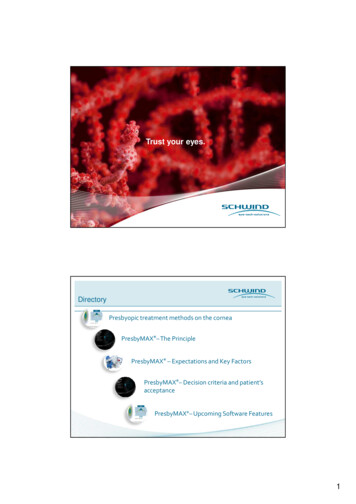
Transcription
Trust your eyes.DirectoryPresbyopic treatment methods on the corneaPresbyMAX – The PrinciplePresbyMAX – Expectations and Key FactorsPresbyMAX – Decision criteria and patient’sacceptancePresbyMAX – Upcoming Software Features1
Introduction and Basics:Visual Acuity and Object Distance related to Age120%100%Emmetrope 25yoEmmetrope 45yo60%Emmetrope 55yo40%20%120%0%01234567Object distance (m)8100%80%The average near (less than 1 m)visual acuity in emmetropes until40 years of age is ok, the seniorpopulation shows diminishedperformance.Visual Acuity (%)Visual Acuity (%)80%The average distance (more than1 m) visual acuity in emmetropesuntil 45 years of age is high, thesenior population showsdiminished performance.Emmetrope 25yoEmmetrope 45yoEmmetrope 00,901,00Object distance (m)Introduction and comfortClear focus, i.e. sharp retinal imageAnisometropia (more than 1 D)Highly accept in patients and physiciansLoss in stereopsisIndependent from pupil sizefarDEintermediateNDEnear2
Introduction and scomfortClear foci; i.e. two sharp images on the retinaDisturbing vision because of „steps“ betweenzonesDoes typically not cover the whole distancerange, especially not the intermediate partPupil size critically dependentfarDEORintermediateNDEnearIntroduction and Basics:Q-value adjustedAdvantage/ComfortExtended depth-of-focusDisadvantage/DiscomfortThe Q-value is no predictor for visualperformanceThe Q-value describes the shape between the Influenced by the change in radius of curvaturecornea centre and periphery(dioptric power); i.e. kind of unpredictedUnilateral (non-dominant eye)farintermediatenear3
Introduction and DiscomfortCovers the whole distance range due todifferent foci for distance, intermediate, nearPupil size dependentTypically bilateral which keeps stereopsisTime of (neural) adaptationPossibly reduced contrast sensitivityfarDEORintermediateNDEnearSCHWIND PresbyMAX vs. Competing Multifocal Technologiesmicro-monovision (ZEiSS) Aspheric (Nidek)DominantEyePresbyMAXPresbyMAX ear4
SCHWIND PresbyMAX vs. Competing TechnologiesMonovisionDENDEAMO VISXCustomVue PresbyopiaDENDETechnolas PVSupracorDENDENidekPAC AsphericDENDEZEiSSLaser Blended VisionDENDEAlcon WavelightQ-value adjustedDENDESCHWINDPresbyMAXDENDESCHWINDPresbyMAX µmonovisionDENDEIntermediate Near(70cm)(40cm)Far ( 5m)Alternative Presbyopic Solutions:IntraCORIntrastromal presbyopia treatment using photodisruption with the Technolas femtosecond Five rings (1.8, 2.2, 2.6, 3.0 and 3.4 mm in diameter) are created Cutting design and stromal depth based on refractive error A shift towards myopia exists due to central corneal steepening (hyper-prolate shape)Advantage/ComfortDisadvantage/DiscomfortFast visual recoveryNo refractive correction procedure, i.e. for„emmetropes“ onlyMinimally invasiveNo reverse application or re-treatmentNo tissue removalDifficulties in post-LASIK patients existDifficulties for LASIK post-IntraCOR5
Alternative Presbyopic Solutions:Corneal InlayIntracorneal inlays have been designed to create a small aperture effect or central steepening.The implant is intended to be placed intra-stromally either under a corneal flap or into a cornealpocket. Placement of the CI will be centered over the pupil, typically in the non-dominant eye.I.II.III.The AcuFocus Kamra corneal inlay (US): Ø 3.8 mm, 10 µm thick, central opening of Ø 1.6mm, thousands of small laser openings for good corneal nutrition transportFlexivue Micro-Lens (NL): clear circular implant of Ø 1.5 mm, 10 µm thick in the periphery,increase of 24 to 40 µm to the centre, out of hydrogel (hydrophilic polymer)PresbyLens (US): clear circular implant of Ø 2 mm – like a tiny contact lens – out of hydrogelAdvantage/ComfortEasily removed or replacedDisadvantage/DiscomfortNo refractive correction procedure, i.e. for„emmetropes“ onlyIncreased depth-of-focus without tissueremovalReally fast recoveryPresbyMAX - Unique Treatment RangeBefore PresbyMAX Limited treatment rangee.g. only hyperopic patientse.g. only patients with minor astigmatisme.g. no presbyopia treatment ofemmetropic or myopic patientse.g. only in combination with standardtreatmentse.g. only in combination with wavefrontguided treatmentsWith PresbyMAX Presbyopia software that offersa broad treatment spectrum for differentindications:Treatment of emmetropic, myopic,hyperopic, and astigmatic eyesCorrection of these visual defects can beperformed as “Aberration-Free” or“Customized” treatmentsAny treatment method possible:PRK, TransPRK, LASEK, LASIK andFemtoLASIK6
PresbyMAX - The Principleextendeddepth-of-focusPresbyMAX multiaspheric corneaPresbyMAX pseudo-far-pointfoveolaPresbyMAX pseudo-near-pointIntroduction and Basics:Visual Acuity ScalesDistance Visual Acuity ScalesNear Visual Acuity 0Nieden(40 cm)logRAD(40 cm)RevisedJaeger(35 cm)-0.2---0.1-N10.0J1: 1.00N20.1J2: 0.80N30.2J4: 0.63N40.3J5: 0.50N50.4J6: 0.40N60.5J8: 0.32N70.6J9: 0.25N80.7J10: 0.20N90.8J12: 0.16N100.9J13: 0.13N111.0J14: 0.10N127
PresbyMAX - ExpectationsReading Acuity vs. Print Size» 0.8 logRAD (J12; 20/125) 20 Pt @ 40 cm» 0.7 logRAD (J10; 20/100) 18 Pt @ 40 cm» 0.5 logRAD (J8; 20/63) 12 Pt @ 40 cm» 0.4 logRAD (J6; 20/50) 10 Pt @ 40 cmnormally suffices to clearly recognizenewspaper print in well lit conditions» 0.2 logRAD (J4; 20/30) 6 Pt @ 40 cmPupil 3.0 mm3.8 mm4.5 mm5.5 mmFar(6 m)Far Intermediate(1.5 m)Intermediate(70 cm)Near(40 cm)8
Visual Acuity after PresbyMAX related to different Pupil SizesVisual Acuity as a function of the object distance100%90%80%Visual Acuity (%)70%60%PresbyMAX V2 3D (6 mm)PresbyMAX V2 3D (3,8 mm)PresbyMAX V2 3D (2 ,60 50,706 sual Acuity after PresbyMAX related to different AdditionsVisual Acuity as a function of the object distance120%100%As a compromise between multifocality,distance and near UCVAs, consider planningadditions between 1.25 D to 2.50 DVisual AcuityAcuity (%)(%)Visual80%Emmetrope (55 yo)PresbyMAX V2 2D (50 yo)PresbyMAX V2 3D (60 yo)60%40%20%0%0,0000,10 10,2020,3030,400,5040,60 50,706 0,800,9071,008ObjectObjectdistancedistance(m)(m)9
PresbyMAX - ExpectationsUncorrected Visual Acuity over time101DUCVA (20/n)NUCVA (Jm)20252NUCVA (Jm)DUCVA (20/n)1530354030123456789101112Follow-up time (months)The postoperative progress behaves in all refraction types similarbut the acceptance patient by patient may differ.PresbyMAX - Key Factors for SuccessPatients with positive thinking preoperatively knowing that reduced distance visionpostoperatively (DBCVA pre-op vs. UCVA post-op) may occur.Trial with multifocal contact lenses (centre for near, periphery for distance) could be doneprior to surgery or easier, even if no influence/effect in multifocality (SphAb) can bedemonstrated, simulate a vision of 1 to 2 lines less than BSCVA and ask for thepostoperative acceptance (e.g. simulate distance refraction 0.25 to 0.50 D less than BCVAto the patient; simulate near refraction with addition 0.25 to 0.50 less than BCVA to thepatient).Most satisfied patients are hyperopes, then high astigmatics, then high myopes,then emmetropes, then low myopes.10
PresbyMAX - a possible Trial Contact LensCibaVision AirOptix Aqua Multifocalaus AirOptix Kontaktlinsen BroschürePresbyMAX - Key Factors for SuccessExports are done for selected OZ» between 5.8 and 6.3 mm ( 6.0 mm) in presbyopic myopia,» between 6.2 and 6.7 mm ( 6.5 mm) in presbyopic hyperopia,» between 6.5 and 7.0 mm ( 6.8 mm) in presbyopic astigmatism dominanceMake sure the ablation map is large enough for the scotopic pupil size.Do both eyes simultaneously since otherwise the binocular vision will suffer from themultifocality on only 1 eye (anisometropia and aniseikonia).Perform treatments on the corneal vertex to reduce induction of coma aberrationsdisturbing vision at all distances.11
PresbyMAX - The PrinciplesTargets for the Central and Mid-Peripheral AreasNon-dominant EyeDominant EyePresbyMAX-0.5D-1.75D 0.0D-1.75D-0.5D-1.75D-0.875Dwith µ-monovision-0.125D-1.0D 0.75DPresbyMAX The Software Solution V4.4: Hyp.Astigmatism12
PresbyMAX The Software Solution V4.4: Myo.AstigmatismPresbyMAX with µ-monovisionThe Software Solution V4.4: Hyp.Astigmatism13
PresbyMAX - The Presbyopic CompensationSCHWIND PresbyMAX proposes a presbyopiccompensation based on the age of the patient.Addition as a function of age4,003,503,00Addition 530354045505560657075Age (years old)PresbyMAX - GuideSCHWIND Recommendation Document14
Re-treatment OptionsPresbyMAX can be repeated if reading-spectacles demandsrenew.PresbyMAX can be repeated if reading quality (multifocality) isnot sufficient but distance vision is satisfying.Aberration-Free treatment (with equal optical zone size toprevious PresbyMAX procedure) can be performed on top forimproved distance correction if reading quality (multifocality) issatisfying.PresbyMAX Reversal option with distance best correctedrefraction included can be performed if the patient does notaccept the PresbyMAX concept at all (too much compromisefor the individual).Due to healing process and neuronal adaptation, a re-treatmentprocedure shall not be performed prior 6 months after surgery.PresbyMAX – The Reversal Concept15
PresbyMAX after Previous RefractiveSurgeryPrevious Corneal Refractive Surgery (with the aim of emmetropicdistance vision)Decision shall be equal to patients with virgin corneae.Futhermore, the SCHWIND decision tree for Aberration-Free, Corneal andOcular Wavefront treatments might be consideredPrevious cataract surgery (natural lens exchange)Multifocal enhancement can be performed on the patient’s cornea.Intraocular Surgery after PresbyMAX Aspheric IntraOcular Lenses:Properly calculated aspheric lenses (in the sense of aberration-neutral) after PresbyMAX provide thebest quality of vision without compromising the already achieved pseudoaccommodation. (Nodecentration and tilting of the IOL and correct IOL power assumed)Spheric IntraOcular Lenses:Spheric Ienses induce positive spherical aberration and thus would remove in part or in total thealready achieved pseudo-accommodation.Multifocal IntraOcular Lenses:Multifocal (refractive, diffractive, or accommodative) lenses induce negative spherical aberration andmultiple foci and thus would enhance the already achieved pseudoaccommodation.But centration issues of the lenses become critical and may induce large amounts of coma from themisalignment between the PresbyMAX multifocal cornea and the multifocal IOL.16
Thank you very much for your kind attention!Vielen Dank für Ihre Aufmerksamkeit!¡Muchas gracias por su amable atención!SCHWIND eye-tech-solutionsfon:fax:email:internet: 49(0)6027 / 5 08-0 49(0)6027 / 5 HWIND eye-tech-solutions GmbH & Co. KG · Mainparkstrasse 6-10 · 63801 Kleinostheim · Germany17
CustomVue Presbyopia DE NDE Technolas PV Supracor DE NDE Nidek PAC Aspheric DE NDE ZEiSS Laser Blended Vision DE NDE Alcon Wavelight Q-value adjusted DE NDE SCHWIND PresbyMAX DE NDE SCHWIND PresbyMAX µ-monovision DE NDE SCHWIND PresbyMAX vs. Competing Technologies Alternative Presbyop

